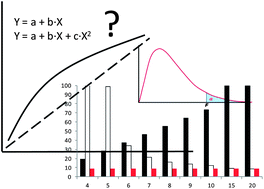Notes on the use of Mandel's test to check for nonlinearity in laboratory calibrations
Abstract
The assessment of the straight line behaviour of a calibration function is of paramount importance to finally decide on the linear range of an analytical procedure and to proceed with the correct calculation of the confidence interval associated with the magnitude of the property being studied. Mandel's test is a straightforward and simple test that, despite being suggested by IUPAC in 1998, has not been applied broadly. The present work studies the validity of the IUPAC approach where the degrees of freedom become simplified, compares it to the original definition given by Mandel, and reviews its correct interpretation. Simulations were made varying the number of data points considered in a calibration (from 4 to 500), as well as the magnitude of the variances of the linear and non-linear models. It was found that the IUPAC simplification is not valid in general although it can be used safely when the variances of the linear and alternative models are very similar, typically when they differ by less than 10%. It is also noticed that application of Mandel's test to routine calibrations (e.g. 6 concentration levels times 4 replicates each) would not be suitable for differentiating between linear and nonlinear models even when their variances differ by 25%.


 Please wait while we load your content...
Please wait while we load your content...